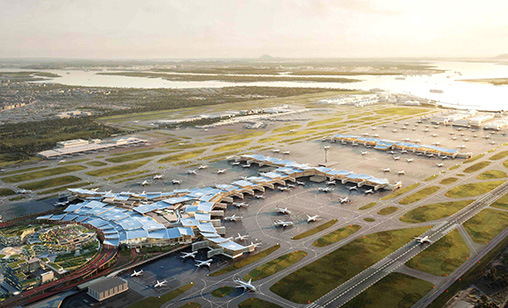Airports
Region investing heavily in airport renewal and construction
June 1st 2025
Airport development in the Asia-Pacific continues to lead the sector’s growth as countries across the region invest billions of dollars to cater for forecast air traffic expansion. Read More »
In a recent Airports Council International (ACI) report, the industry’s lobby group said US$240 billion will be spent on upgrading existing facilities (brown field projects) and building new airports (greenfield projects) in the Asia-Pacific in the next decade, almost 50% of a $488 billion investment in airport projects worldwide.
And there is little doubt more investment will be needed. In 2053, when it is forecast the Asia-Pacific and the Middle East will be serving nearly 11 billion passengers compared with 3.9 billion passengers in 2024.
 |
A notable recent development in the region was the official Terminal 5 (T5) ground breaking ceremony at Singapore’s Changi Airport. T5 is designed to handle about 50 million passengers a year, eventually increasing the airport’s annual capacity to approximately 140 million passengers. The existing four Changi terminals can process 90 million passengers annually. T5 was put on hold for two years during the pandemic but its construction is being accelerated with the goal of opening its doors in the 2030s.
Also under construction is Tokyo Narita’s third runway C and the extension of Runway B by 1,000 meters. The upgrades are planned for operations from March 2029. The project, dubbed “the second opening” of Narita since its inauguration in 1978 will increase the airport’s annual landing and take-off capability from 300,000 flights a year at present to a maximum of 500,000 a year.
The ACI Asia-Pacific & Middle East study has drawn up a road map for existing airports and new airport infrastructure.
Brownfield Development, the modernisation of existing airports, will require $136 billion to upgrade existing airports that will add capacity of 680 million passengers and 14 million tonnes of cargo a year to the facilities. Greenfield Development is forecast to have $104 billion available for new airport construction that will provide passenger capacity of 562 million and 57 million tonnes of cargo.
The investment will create additional capacity for 1.24 billion passengers - the equivalent of more than 13 airports the size of Dubai International Airport, the world’s busiest airport for international passengers, and 71 million tonnes of cargo capacity. Cargo capacity alone will be near 14 times the cargo throughput of Hong Kong International Airport, the top ranked airport for cargo in the world. This significant increase will ensure airports in the Asia-Pacific and the Middle East will handle growth.
“The $240 billion investment is not just about concrete and runways, it is about socio-economic development in the region,” ACI Asia-Pacific & Middle East president, SGK Kishore, said. “Enhanced passenger experiences will stimulate tourism and business travel and bolstered cargo capacity will streamline supply chains and drive regional trade and development.”
ACI Asia-Pacific & Middle East director general, Stefano Baronci, said “infrastructure development alone cannot support growth to its full potential. In today’s increasingly complex economic landscape, we need the continuous support of governments to liberalise air transportation and streamline visa policies. “In contrast, protectionist measures hinder progress and opportunity.”
GlobalData’s research agrees with the ACI that the Asia-Pacific is the fastest airport market growth in the world and will continue to do so for the next decade as China, India and several Southeast Asian nations are investing heavily in airport construction and the modernization of existing facilities.
In a separate report recently released in Shanghai, ACI’s Air Connectivity Ranking 2024 shows a significant 14% increase in connectivity for airports in the Asia-Pacific and the Middle East, driven by strong international demand, robust network recovery and the return of major travel corridors.
The Air Connectivity Ranking assesses performance based network scale and frequency, the economic weight of destinations and connection quality and efficiency. It reports the Asia-Pacific has recorded a remarkable 13% jump in overall connectivity compared with two years ago and the Middle East has achieved an impressive 28% increase, surpassing all post-COVID recovery forecasts.
In Asia-Pacific, intra-regional connections are close to pre-pandemic levels, trailing 2019 by 0.2%. At the same time, intercontinental connectivity is on the rise, showing a solid 4% increase. The Middle East, is setting a new pace. Intra-regional and inter-continent connectivity have exceeded pre-pandemic levels by 18% and 16%, respectively.
Key findings of the rankings are:
* Airports in the Asia-Pacific and the Middle East experienced across-the-board connectivity growth in 2024, driven by China’s reopening and route expansion.
* 80% of the top 300 airports in the world have fully recovered with larger hubs at the top of the table because of the resurgence in international travel.
* Domestic city pairs decreased by an average of 1% compared with 2023, suggesting a post-COVID emphasis on international expansion.
* International city pairs across all airport categories rose by an average of 17%, highlighting the strong return to cross-border travel.
* While intra-APAC passenger travel in 2024 was close to 2019 levels, travel to Europe, the Middle East and Africa has surpassed it, driven by Gulf hubs. Passenger traffic from the Asia-Pacific to the Americas still trails 2019 levels.
Despite increased competition, Dubai maintained its position as the leading airport in APAC and the Middle East. Seoul Incheon, Singapore Changi, Shanghai Pudong and Beijing Capital saw improved rankings and indices, reflecting strong outbound tourism and network adjustments.
Baronci said air connectivity is not only relevant for passengers seeking more travel options and convenience; it is equally crucial for supporting global trade and economic resilience, particularly through belly hold cargo capacity.
“In the face of growing geopolitical and trade tensions, we urge governments to prioritise air service liberalisation, streamlined visa policies and transparent slot allocation frameworks,” he said.
Anna Travers says:
September 17th 2025 03:18am